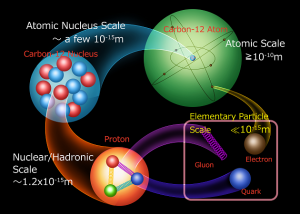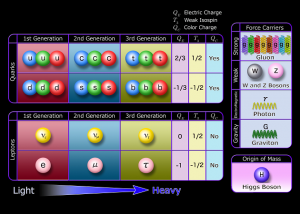Theoretical Particle and Hadron Physics Group performs theoretical studies on the properties of elementary particles and their interactions. These particles are the essential ingredients of our world, and we would like to reveal the origin and history of the Universe by studying them.
After a brief introduction to elementary particle theory and its relation to the Universe, the work done by individual group members will be described.
[Group Members] [Theoretical Particle and Hadron Physics Web Site]
What is elementary particle theory?
An elementary particle is a particle that has no substructure, and that cannot be decomposed into other particles. The entire Universe is considered to consist of elementary particles, and their properties determine the nature of matter. Understanding these properties is the goal of elementary particle theory. The study of elementary particles has a long history, and explanations concerning their nature have changed with time. The currently accepted explanation is summarized in the figure below, and is referred to as the Standard Model (SM). The theories contained in the SM are capable of explaining almost all experimental observations. However, although the SM has been highly successful, it contains many parameters (15 or more) that can be adjusted in order to fit experimental results. Moreover, recent cosmological observations suggest the existence of dark energy and dark matter in the Universe, which are not taken into consideration in the SM. Einstein’s General Theory of Relativity is also incompatible with the SM. Therefore, physicists do not regard the SM as the final fundamental theory, and would like to determine the origin of the structure of the SM and its relation to the origin of the Universe.
The Universe and elementary particles
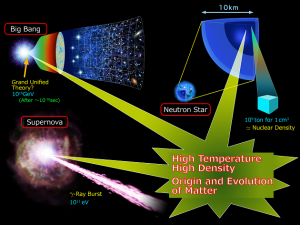 Matter and its properties reflect the nature of the Universe. Verifying the existence of dark matter, or the results of extremely high-energy experiments (high energy = short distance) could lead to a failure of the SM. Extreme environments in the Universe, which are the target of CORE-U, can be thought of as experimental laboratories, in which high-energy phenomena occur that cannot be realized on Earth. Consequently, there has been considerable effort by physicists worldwide to develop an elementary particle theory that can explain the results of experimental observations of such phenomena.
Matter and its properties reflect the nature of the Universe. Verifying the existence of dark matter, or the results of extremely high-energy experiments (high energy = short distance) could lead to a failure of the SM. Extreme environments in the Universe, which are the target of CORE-U, can be thought of as experimental laboratories, in which high-energy phenomena occur that cannot be realized on Earth. Consequently, there has been considerable effort by physicists worldwide to develop an elementary particle theory that can explain the results of experimental observations of such phenomena.
Group Members
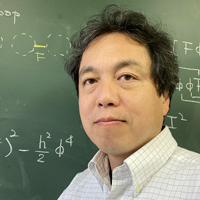
Tomohiro Inagaki (Professor)
The universe is full of many mysteries. It is considered that the universe has passed the inflationary expanding era in order to realize the homogeneous and flat universe. It seems that the universe is filled with unknown matter, dark matter, from the rotation of galaxies and the gravitational lensing effect caused by the bending of light around a massive object. Observed redshift of distant supernovae indicates the existence of the unknown energy, dark energy, that fills our universe. There are more fundamental questions. Why is space three-dimensional? Are there really only three? I am looking for a theory that solves such mysteries by expanding the standard model of elementary particle physics or modifying General Relativity. I try to approach the answer through analytical calculations and computer simulations, starting from an initial state of the universe at high temperature and high density that could not be reached by experiments. In collaboration with research groups in Spain, Russia, China, and Azerbaijan, we are focusing on the role of fermionic fields, and are conducting research on constructing new theoretical models and inspecting the models by observation.
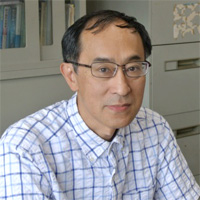
Takuya Morozumi (Associate Professor)
The subject related to the Core-U project on which I am currently working is research into the violation of charge parity (CP) symmetry. CP symmetry is a key symmetry, and many believe that CP violation and the asymmetry of matter and antimatter in our Universe are related to each other. However, revealing the connection between the asymmetry observed on a macroscopic scale and CP violation in the microscopic world is a challenging problem. The precision of measurements of CP violations in laboratory experiments under well-controlled conditions can be improved by repeating the measurements many times. In contrast, for the CP asymmetry observed in the Universe, experiments cannot be repeated. The matter-antimatter asymmetry that is observed today was produced only one time at a certain period in the history of the Universe. Therefore, to test theoretical hypotheses, it would be necessary to return to and observe that time armed with our present knowledge based upon the laws of nature. However, since the observable Universe is limited in size and our observations lack precision, this is difficult to achieve. Considering the situation, I am currently using a working hypothesis to study how the density of the matter-antimatter asymmetry evolves with time. We are working on a simple scalar field theory which includes only a complex scalar field, and have obtained interesting results which may relate to the question of the origin of matter (See R. Hotta, T. Morozumi, and H. Takata, Phys. Rev. D90 (2014) 016008).

Ken-Ichi Ishikawa (Associate Professor)
Theoretical particle physicists can approach problems using pencils and notebooks. However, I am using supercomputers to numerically solve problems related to quantum chromodynamics (QCD). QCD is a component of the SM, and explains the properties of quarks and gluons, as shown in the image and particle table at the top of this page. At a glance, the equation of motion in QCD appears to be simple. However, obtaining a solution in order to provide theoretical values to compare with experimental results is not easy. I am currently using supercomputers to carry out numerical studies on the properties of protons and neutrons, in addition to the SM parameters, based on lattice QCD theory. Since 2013, I am working on a project using the K computer to explore the physics of QCD. (image: a proton in a lattice box)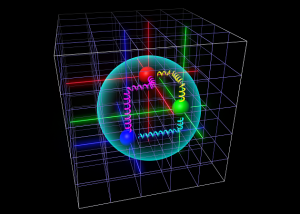
Illustration by AND You INC.

